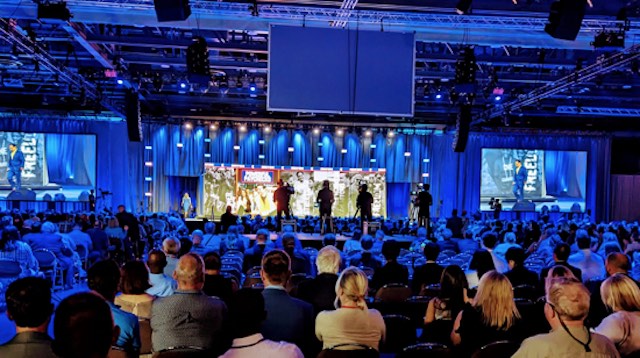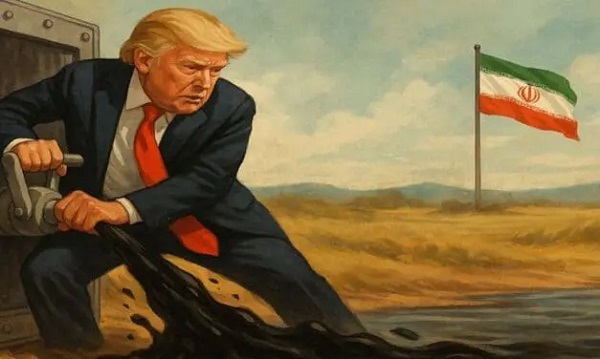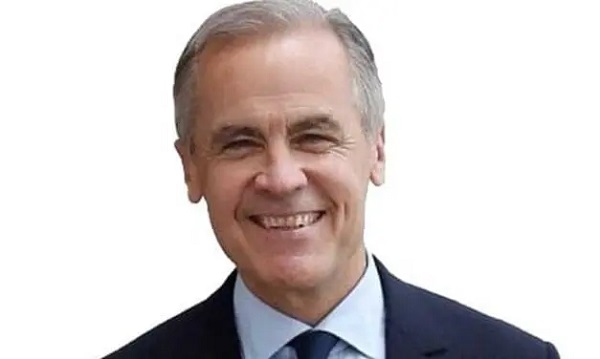Opinion
Grounded -The PM’s plane is transformed into a metaphor

|
|
I stopped by the Conservative Convention on Thursday night, just briefly. The mood (which I ascertained by asking several Conservative acquaintances “What’s the mood?”) was cautiously optimistic. The Conservatives I met — a random sample, skewed older because I haven’t met a new generation of Conservative activists — sounded pleased with Pierre Poilievre’s summer. But they also figure they’re getting a second look because voters have given the Liberals a hundred looks and they always see the same thing.
Later, word came from India that Justin Trudeau’s airplane had malfunctioned, stranding him, one hopes only briefly. It’s always a drag when a politician’s vehicle turns into a metaphor so obvious it begs to go right into the headline. As for the cause of the breakdown, I’m no mechanic, but I’m gonna bet $20 on “The gods decided to smite Trudeau for hubris.” Here’s what the PM tweeted or xeeted before things started falling off his ride home:
One can imagine the other world leaders’ glee whenever this guy shows up. “Oh, it’s Justin Trudeau, here to push for greater ambition!” Shall we peer into their briefing binders? Let’s look at Canada’s performance on every single issue Trudeau mentions, in order.
Paul Wells is a reader-supported publication. To receive new posts and support my work, consider becoming a free or paid subscriber.
On climate change, Canada ranks 58th of 63 jurisdictions in the global Climate Change Performance Index. The country page for Canada uses the words “very low” three times in the first two sentences.
On gender equality, the World Economic Forum (!) ranks Canada 30th behind a bunch of other G-20 members.
On global health, this article in Britain’s BMJ journal calls Canada “a high income country that frames itself as a global health leader yet became one of the most prominent hoarders of the limited global covid-19 vaccine supply.”
On inclusive growth, the United Nations Conference on Trade and Development has a composite indicator called the Inclusive Growth Index. Canada’s value is 64.1, just behind the United States (!) and Australia, further behind most of Europe, stomped by Norway at 76.9%.
On support for Ukraine, the German Kiel Institute think tank ranks Canadafifth in the world, and third as a share of GDP, for financial support; and 8th in the world, or 21st as a share of GDP, for military support.
Almost all of these results are easy enough to understand. A small number are quite honourable. But none reads to me as any kind of license to wander around, administering lessons to other countries. I just finished reading John Williams’ luminous 1965 novel about university life, Stoner. A minor character in the book mocks the lectures and his fellow students, and eventually stands unmasked as a poser who hasn’t done even the basic reading in his discipline. I found the character strangely familiar. You’d think that after nearly a decade in power, after the fiascos of the UN Security Council bid, the first India trip, the collegiate attempt to impress a schoolgirl with fake trees, the prime minister would have figured out that fewer and fewer people, at home or abroad, are persuaded by his talk.
But this is part of the Liberals’ problem, isn’t it. They still think their moves work. They keep announcing stuff — Digital adoption program! Growth fund! Investment tax credits! Indo-Pacific strategy! Special rapporteur! — and telling themselves Canadians would miss this stuff if it went away. Whereas it’s closer to the truth to say we can’t miss it because its effect was imperceptible when it showed up.
In a moment I’ve mentioned before because it fascinates me, the Liberals called their play a year ago, as soon as they knew they’d be facing Pierre Poilievre. “We are going to see two competing visions,” Randy Boissonault said in reply to Poilievre’s first Question Period question as the Conservative leader. The events of the parliamentary year would spontaneously construct a massive contrast ad. It was the oldest play in the book, first articulated by Pierre Trudeau’s staff 50 years ago: Don’t compare me to the almighty, compare me to the alternative. It doesn’t work as well if people decide they prefer the alternative. It really doesn’t work if the team running the play think it means, “We’re the almighty.”
Share
There may yet be years — two, anyway — before we get to vote in a general election. Obviously much can change. I’ve made it clear, just about every time I’ve written about specific Poilievre policies, that I’ve seen no reason to be optimistic that a change of government would guarantee any improvement in public administration. But what we’ve seen elsewhere — most spectacularly in provincial elections in Quebec and Ontario in 2018 — is that sometimes voters stop caring about that question. They have a simpler question: After a decade in power, does the government in place even notice large, obvious things?
I see the Liberal caucus will be in London, ON this week. Here’s a chance for them to practice noticing large, obvious things. MPs would do well to walk around the city’s downtown core after dark, east of Richmond St., between Dundas and York. If they travel in small groups they’ll probably be safe.
While they witness what a Canadian city looks like in 2023, they might remind themselves that their unofficial 2015 election slogan was “Better Is Always Possible.” And ask themselves how much trouble they’ll be in if voters still believe it.
Lately when I write about the Liberals I upset my Liberal subscribers and when I write about Conservatives I upset my Conservative subscribers. I know it can feel like shtick, but it reflects my conviction that the partisan joust, and the genuine feelings that underpin it, are easier to address than the wicked problems of a chaotic time. And therefore way too tempting to an entire generation of political leadership.
For the Liberals, the challenge has been obvious since 2019: Does Justin Trudeau learn? In 2015 he ran as a disruptor, a guy who had noticed large, obvious things — interest rates were low! Small deficits were more manageable than they had been in years ! — and was willing to be cheeky in ignoring the other parties’ orthodoxies. Stephen Harper and Tom Mulcair were reduced to sputtering outrage that the new kid was making so many cheeky promises on fighter procurement (whoops), electoral reform (never mind), admitting Syrian refugees, legalizing cannabis, and more.
Since about 2017, inevitably, the Trudeau government has undergone a transition that’s common when disruptors become incumbents. He is increasingly forced to defend the state of things, rather than announcing he’s come to change it. He’s changed positions from forward to goal. All his opponents need to do is notice the big, obvious things he seems unable to see. The biggest: It’s become punishingly difficult for too many Canadians to put a roof over their head.
The old Trudeau would have done big, surprising things to show he could see such a thing. The Trudeau who ejected every senator from the Liberal caucus and broke a decade’s taboo against deficit spending would shut down the failed Canada Infrastructure Bank this week and put the savings into a national crisis housing fund. Or, I don’t know, some damned thing.
But of course, the surprising Trudeau of 2015 hadn’t been prime minister yet, had he? This hints at a question a few Liberals are starting to ask themselves. Does he have any juice left in him for more than pieties? He might still have some fight in him, but does he still have the job in him?
He’s already been in the job for longer than Pearson and Diefenbaker were. His indispensable right hand has been chief of staff longer than anyone who ever held the job. They have, for years, already been noticeably eager to administer lessons to others. Would they view a Liberal election defeat as their failure — or ours?
Would a prime minister who views a G-20 summit as a learning opportunity for every country except Canada view an election defeat as anything but further proof that Canada never really deserved him anyway?
This article is from Paul Wells substack.
For the full experience, click to subscribe to Paul Wells.
Click here to support the work of Paul Wells by subscribing to substack
Business
Dallas mayor invites NYers to first ‘sanctuary city from socialism’

From The Center Square
By
After the self-described socialist Zohran Mamdani won the Democratic primary for mayor in New York, Dallas Mayor Eric Johnson invited New Yorkers and others to move to Dallas.
Mamdani has vowed to implement a wide range of tax increases on corporations and property and to “shift the tax burden” to “richer and whiter neighborhoods.”
New York businesses and individuals have already been relocating to states like Texas, which has no corporate or personal income taxes.
Johnson, a Black mayor and former Democrat, switched parties to become a Republican in 2023 after opposing a city council tax hike, The Center Square reported.
“Dear Concerned New York City Resident or Business Owner: Don’t panic,” Johnson said. “Just move to Dallas, where we strongly support our police, value our partners in the business community, embrace free markets, shun excessive regulation, and protect the American Dream!”
Fortune 500 companies and others in recent years continue to relocate their headquarters to Dallas; it’s also home to the new Texas Stock Exchange (TXSE). The TXSE will provide an alternative to the New York Stock Exchange and Nasdaq and there are already more finance professionals in Texas than in New York, TXSE Group Inc. founder and CEO James Lee argues.
From 2020-2023, the Dallas-Fort Worth-Arlington MSA reported the greatest percentage of growth in the country of 34%, The Center Square reported.
Johnson on Thursday continued his invitation to New Yorkers and others living in “socialist” sanctuary cities, saying on social media, “If your city is (or is about to be) a sanctuary for criminals, mayhem, job-killing regulations, and failed socialist experiments, I have a modest invitation for you: MOVE TO DALLAS. You can call us the nation’s first official ‘Sanctuary City from Socialism.’”
“We value free enterprise, law and order, and our first responders. Common sense and the American Dream still reside here. We have all your big-city comforts and conveniences without the suffocating vice grip of government bureaucrats.”
As many Democratic-led cities joined a movement to defund their police departments, Johnson prioritized police funding and supporting law and order.
“Back in the 1800s, people moving to Texas for greater opportunities would etch ‘GTT’ for ‘Gone to Texas’ on their doors moving to the Mexican colony of Tejas,” Johnson continued, referring to Americans who moved to the Mexican colony of Tejas to acquire land grants from the Mexican government.
“If you’re a New Yorker heading to Dallas, maybe try ‘GTD’ to let fellow lovers of law and order know where you’ve gone,” Johnson said.
Modern-day GTT movers, including a large number of New Yorkers, cite high personal income taxes, high property taxes, high costs of living, high crime, and other factors as their reasons for leaving their states and moving to Texas, according to multiple reports over the last few years.
In response to Johnson’s invitation, Gov. Greg Abbott said, “Dallas is the first self-declared “Sanctuary City from Socialism. The State of Texas will provide whatever support is needed to fulfill that mission.”
The governor has already been doing this by signing pro-business bills into law and awarding Texas Enterprise Grants to businesses that relocate or expand operations in Texas, many of which are doing so in the Dallas area.
“Texas truly is the Best State for Business and stands as a model for the nation,” Abbott said. “Freedom is a magnet, and Texas offers entrepreneurs and hardworking Texans the freedom to succeed. When choosing where to relocate or expand their businesses, more innovative industry leaders recognize the competitive advantages found only in Texas. The nation’s leading CEOs continually cite our pro-growth economic policies – with no corporate income tax and no personal income tax – along with our young, skilled, diverse, and growing workforce, easy access to global markets, robust infrastructure, and predictable business-friendly regulations.”
conflict
US airstrike on Iran’s nuclear facilities. Was it obliteration?

A satellite image of the Isfahan nuclear research center in Iran shows visible damage to structures and nearby tunnel entrances from recent US airstrikes. / Satellite image (c) 2025 Maxar Technologies.
 Seymour Hersh
Seymour Hersh
The US attack on Iran may not have wiped out its nuclear ambitions but it did set them back years
I started my career in journalism during the early 1960s as a reporter for the City News Bureau of Chicago, a now long-gone local news agency that was set up by the Chicago newspapers in the 1890s to cover the police and fire departments, City Hall, the courts, the morgue, and so on. It was a training ground, and the essential message for its aspiring reporters was: “If your mother says she loves you, check it out.”
It was a message I wish our cable networks would take to heart. CNN and MSNBC, basing their reporting on an alleged Defense Intelligence Agency analysis, have consistently reported that the Air Force raids in Iran on June 22 did not accomplish their primary goal: total destruction of Iran’s nuclear-weapons capacity. US newspapers also joined in, but it was the two nominally liberal cable channels, with their dislike—make that contempt—for President Donald Trump, that drove the early coverage.
There was no DIA analysis per se. All US units that engage in combat must file an “after-action report” to the DIA after a military engagement. In this case, the report would have come from the US Central Command, located at MacDill Air Force base in Tampa, Florida. CENTCOM is responsible for all US military operations in the Middle East, Egypt, Central Asia, Afghanistan, and Pakistan. One US official involved in the process told me that “the first thing out of the box is you have to tell your boss what happened.” It was that initial report of the bombing attack that was forwarded to DIA headquarters along the Potomac River in Washington and copied or summarized by someone not authorized to do so and sent to the various media outlets.
The view of many who were involved in the planning and execution of the mission is that the report was summarized and leaked “for political purposes”—to cast immediate doubt on the success of the mission. The early reports went so far as to suggest that Iran’s nuclear program has survived incapacitation by the attack. Seven US B-2 “Spirit” bombers, each carrying two deep-penetration “bunker-busters” weighing 30,000 pounds, had flown without challenge from their base in Missouri to the primary target: Iran’s Fordo nuclear facility, concealed deep inside a mountain twenty miles north of the city of Qom.
The planning for the attack began with the knowledge that the main target—the working area of the nuclear program—was buried at least 260 feet below the rocky surface at Fordo. The gas centrifuges spinning there were repeatedly enriching uranium, in what is known as a cascade, not to weapons-grade level—uranium-235 isotopes enriched to 90 percent—but to 60 percent. Further processing to create weapons grade uranium, if Iran chose to do so, could be done in a matter of weeks, or less. The Air Force planning group had also been informed before the bombing raid, most likely by the Israelis, who have a vast spy network in Iran, that more than 450 pounds of the enriched gas stored at Fordo had been shipped to safety at another vital Iranian nuclear site at Isfahan, 215 miles south of Tehran. Isfahan was the only known facility in Iran capable of converting the Fordo gas into a highly enriched metal—a critical early stage of building the bomb. Isfahan also was a separate target of the US attack on Fordo, and was pulverized by Tomahawk missiles fired by a U.S. submarine operating in the Gulf of Aden, off Yemen.
As a journalist who for decades has covered the nascent nuclear crisis in the Middle East, it seemed clear to me and to informed friends I have in Washington and Israel that if Fordo somehow survived its bunker-buster attack, as was initially suggested, and continued to enrich more uranium, Isfahan would not. No enrichment, no Iranian bomb.
I’ve been frustrated and angry at cable news coverage for years, and that includes Fox News, too, and decided to try and find the real story. If your mother says she loves you, check it out. And I checked out enough of it to share.
I was told that “the first question for the American planners was how big was the actual workspace at Fordo? Was it a structure? We had to find that out before we got rid of it.” Some of the planners estimated that the working space “was the size of two hockey rinks: 200 feet long and 85 feet wide.” It came to 34,000 square feet. The height of the underground working space was assumed to be ten-and-a-half feet—I was not told the genesis of that assumption—and the size of the target was determined to be 357,000 cubic feet.
The next step was to measure the power of the dozen or more bunker-busters that were planned to be “carefully spaced and dropped” by the US B-2 bombers, using the most advanced guidance systems. (During one high-level session in Washington, one of the Air Force planners was asked what would happen if the B-2’s guidance systems were corrupted by an outside signal. “We’d miss the target” was the answer.)
I was assured that even if the rough estimate of the working space at Fordo was far off, the bombers targeting Fordo each carried a 30,000-pound bomb with an explosive payload of as much as five thousand pounds, which was more than enough to pulverize the mythical hockey rinks, or even a much larger working space.
Some of the bombs were also outfitted with what is known as a hard target void sensing fuze, which enabled the bombs to penetrate multiple layers of a site like Fordo before detonating. This would maximize the destructive effect. Each bomb, dropped in sequence, would create a force of rubble that would cause increasing havoc in the working areas deep inside the mountain.
“The bombs made their own hole. We built a 30,000-pound steel bullet,” the official told me, referring with pride to the bunker-busters.
Most important, he said, was that there were no post-strike hints detected of radioactivity—more evidence that the 450 pounds of enriched uranium had been moved from Fordo to the reprocessing site at Isfahan prior to the US attack there, which was code-named “Midnight Hammer.” That operation included a third US strike at yet another nuclear facility at Natanz.
“The Air Force got everything on the hit list,” the official told me. “Even if Iran rebuilds some centrifuges, it will still need Isfahan. There is no conversion capability without it.”
Why not, I asked, tell the public about the success of the raid and the fact that Iran no longer has a potential nuclear weapon?
The answer: “There will be a top-secret report about all of this, but we don’t tell people how hard we work. We tell the public what we think it wants to hear.”
The US official, asked about the future of the Iranian nuclear program, quickly acknowledged that “there is a communication problem” when it comes to the fate of the program.
The intent of the strike planners, he said, “was to prevent the Iranians from building a nuclear weapon in the near term—a year or so—with the hope they would not try again. The clear understanding was that there was no expectation to ‘obliterate’ every aspect of their nuclear program. We don’t even know what that is.
“Obliteration means the glass—[eliminating] Iran’s nuclear program—is full. The planning and the results are the glass is half-full. For Trump critics, the results are the glass is half-empty—the centrifuges may have survived and four hundred pounds of 60 percent enriched uranium are missing. The bombs could not be assured to penetrate the centrifuge chamber . . . too deep, but they could cover them up [with rocks and other bomb debris] and in the process cause unknown damage to them.
“Whether the 60 percent [enriched uranium] was there or not is irrelevant because without centrifuges they cannot refine it to weapons grade. Add to this the research and refinement and conversion from gas to metal—required for a bomb—at Isfahan are also gone.
“Results? Glass is half-full . . . a couple of years of respite and uncertain future. So now Trump’s defense is Full Glass. Critics? Half-empty. Reality? Half-full. There you are.”
The immediate beneficiary of the use of US force in Iran will not be a more placid Middle East, but Israel, and Prime Minister Benjamin Netanyahu. The Israeli Air Force and army are still killing massive numbers of Palestinians in Gaza.
There remains no evidence that Iran was on the cusp of becoming a nuclear power. But as the world has known for decades, Israel maintains a significant nuclear arsenal that it officially claims does not exist.
This is a story not about the bigger picture, which is muddled, but about a successful US mission that was the subject of a lot of sloppy reporting because of a reviled president. It would have been a breakthrough had anyone in the mainstream press spoken or written about the double standard that benefits Israel and its nuclear umbrella, but in America that remains a taboo.
-

 Agriculture2 days ago
Agriculture2 days agoCanada’s supply management system is failing consumers
-

 Economy2 days ago
Economy2 days agoTrump opens door to Iranian oil exports
-

 Alberta1 day ago
Alberta1 day agoCOVID mandates protester in Canada released on bail after over 2 years in jail
-

 Business1 day ago
Business1 day agoCanada’s loyalty to globalism is bleeding our economy dry
-

 Crime1 day ago
Crime1 day agoProject Sleeping Giant: Inside the Chinese Mercantile Machine Linking Beijing’s Underground Banks and the Sinaloa Cartel
-

 Alberta1 day ago
Alberta1 day agoAlberta uncorks new rules for liquor and cannabis
-

 Business1 day ago
Business1 day agoCarney’s spending makes Trudeau look like a cheapskate
-

 armed forces23 hours ago
armed forces23 hours agoCanada’s Military Can’t Be Fixed With Cash Alone








